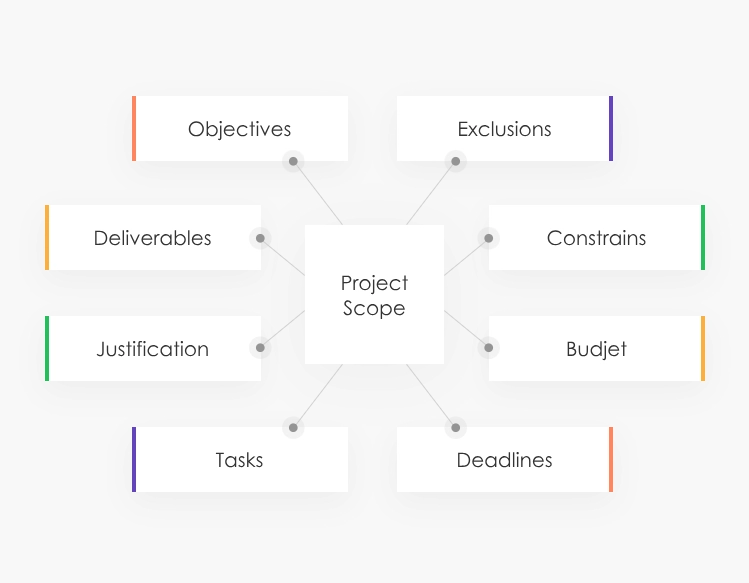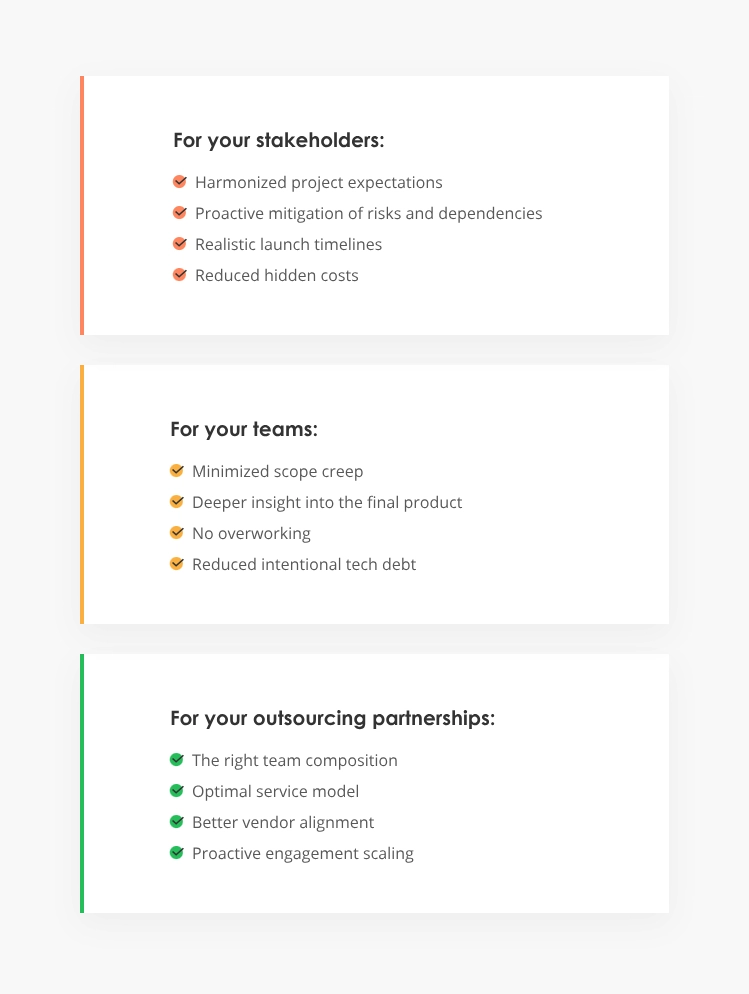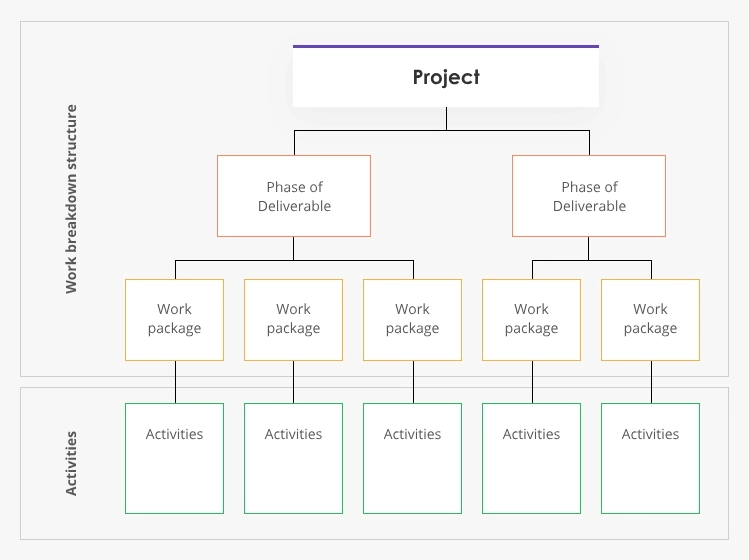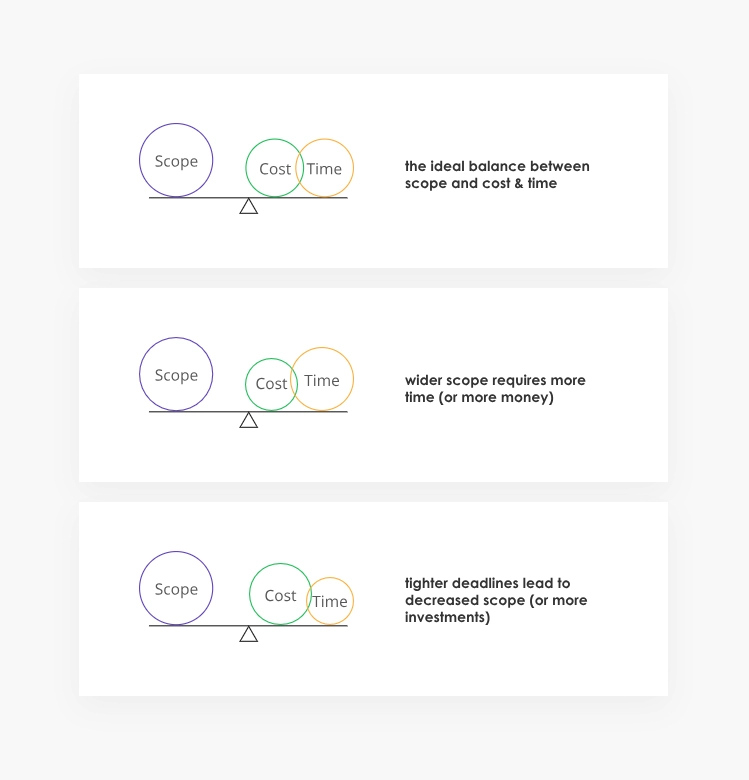The pandemic-propelled growth of online consumption and digital products proved that technologies are the lifeblood of business. Successful IT initiatives generate extra revenue and reduce operations costs. They take you to competitive markets and help you go through the crisis.
But there is a flip side to this story: even the most market-demanded IT projects may fail due to overrun costs and timelines. According to McKinsey, only one in 200 IT projects delivers results on time and within budget. Indeed, you would want to avoid the fate of those 199. One of the ways to do so is to define a detailed project scope.
What is a Project Scope?
Project scope is a detailed outline of all tasks, resources, and deliverables required to complete a project. While describing everything the project has, the scope serves an even more important role: to clarify what activities are excluded.
Project scope is one of the most critical aspects of your software development initiative. It helps you envision what product you get in the end and identify how much time, resources, and work you need to get to the final destination. Typically, you will need to develop a project scope during the planning stage, evolve it further in a project scope statement, and then refine it during each cycle of SDLC.
According to PMI, the scope should cover the following aspects:
- Reason for the project initiation
- Project deliverables
- Product characteristics (or project activities)
- Cost and schedule constraints
- External constraints
Critical Elements of a Project Scope

Project Scope vs. Product Scope
PMI distinguishes between project scope and product scope:
- Project Scope: Activities needed to develop a product, create a service, or achieve a tangible result.
- Product Scope: Functions and features that comprise a product, service, or tangible result.
Vital note: Meeting project scope does not guarantee post-launch success. Sometimes, a project excels from a scope/schedule/budget point and yet, the final product falls short (e.g., failing to generate revenue or win customer approval). It happens when market demands evolve mid-project and don’t match the original plan. To keep up with the market dynamics and adapt your project mid-stream, ensure you have a robust change management procedure.
But watch out: uncontrolled scope change comes with risk.
One feature will turn into five. Simple, minimalistic design suddenly needs more elements. Developers work overtime and still, your project is three months longer than expected. Such scenario occurs so often that it even deserves a name of its own. We present to you, scope creep.
What is a Scope Creep?
Scope creep is the unplanned addition of new features and activities beyond the original scope.
According to the Pulse of Profession Report, scope creep is among the most vexing issues in 33-37% of projects. Organically, scope creep can occur when your team gains new project knowledge and aligns activities to reflect the new circumstances. But it may also come when scope changes are made without considering:
- Customer’s approval
- Time, cost, or resource implications
- Protocol for change management
Unmanaged scope creep leads to project delays, extra costs, substandard product quality, and low team morale. As a preventative measure, make it a rule to:
- Implement a robust scope control process for all your key stakeholders.
- Keep track of all authorized scope changes.
- Regularly check how many of the current project’s activities differ from the original scope.
- Identify and document all unapproved changes, along with their justifications and severity.
Benefits of a Proactive Definition of a Project Scope
A well-defined scope benefits both your external stakeholders and internal teams.
During project initiation, the scope is a mechanism for managing stakeholder expectations. All investors, managers, and vendors understand what contributions they need to make.
When the project kicks off, the scope informs your teams about their responsibilities and expected outcomes. It helps them make the right decisions to drive the project forward within the agreed time and budget.
As you need external help, project scope helps identify which tasks to delegate when forming outsourcing partnerships. It’s a reference point for selecting a service model and assembling a dedicated team with the right competencies. As a vital part of IT service contracts, the scope indicates if your partner lives up to their promises.
Benefits of a Well-Defined Project Scope

How to Define a Project Scope?
To outline a project scope, you need to organize a set of meetings with all stakeholders: from investors and company owners to end users and project teams. Gather all information discussed and, if possible, analyze previous similar projects for insights about the size, cost, timeline, risks, and lessons learned. If available, use the following documents as inputs:
- Project vision statement – a high-level overview of project goals and their fit within the organization’s strategy.
- Assumption log – a document discussing project assumptions and constraints that can influence success.
- Requirements documentation – an outline of stakeholder requirements for the end product (features, functionality, and user value).
- Risk register – a log of potential risks and potential mitigation strategies.
Pro tip: Your vendor can offer a discovery phase – a series of meetings to formalize project vision, define project scope, and elicit initial project requirements.
Once you have gathered your initial information, detail your project scope with these steps.
1. Communicate with Key Project Stakeholders
Identify who handles information about the project’s goals, expectations, deliverables, and scaling plans. PMI refers to these people as a Planning Process Group – a team dedicated to defining your project and product scope.
We suggest the following composition of a Planning Process Group for an outsourcing project:
| The company’s C-level management and decision-makers | – Share information about the project’s vision and goals. – Provide the organization’s procedures, policies, and overall business strategy. – Suggest the expected timeline and budget. – Identify if other projects/activities that depend on this project. |
| In-house tech experts | – Explain a pre-established SDLC process. – Share tech documentation and operational instructions. |
| Outsourcing vendor’s representatives (CTO, solution architect) | – Advise on the SDLC model (if needed). – Recommend optimal team composition, technology stack, and service model. – Advise on a timeline and budget. – Help identify outsourcing risks. |
| Business analyst (on your or vendor’s side) | Translates obtained information into requirements and KPIs. |
| Project manager (on your or vendor’s side) | – Formalizes the project objectives and documents success criteria. – Performs work breakdown structure. |
| The development team | – Estimates low-level tasks. – Advises on a tech stack. |
| External IT consultants (optional) | Consult on areas where you (or your vendor) lack expertise. |
As a formalized procedure for obtaining the required input, we suggest holding workshops – a series of meetings to align your Planning Process Group. Organize successful remote workshops with your outsourcing vendor following our experience-backed recommendations:
- Outline the agenda before a workshop
- Test your communication tools before the meeting
- Prepare ice-breaking and trust-building exercises
- Explain the workshop rules (turn the video on, mute by default)
- Make sure to include the breaks
- Write down the outputs
2. Document Goals, Requirements, and Acceptance Criteria
The first task for your Planning Process Group is to set a clear vision for the project by articulating project goals and value. Discuss:
- What prompted the project’s initiation?
- Which business outcomes do you want to achieve?
- Why do your users need a solution?
- How should your product perform to deliver customer value?
With a rough idea of your final destination, set boundaries to avoid straying off course. Gather initial requirements and compose a list of features and characteristics you’d like to see in your product. How should these features function? How should they not behave?
But just reaching the endpoint won’t be enough. You need to determine what exactly will constitute success. Does “project success” mean producing an MVP as quickly as possible? Does it imply meeting defined quality and security standards? Delivering a “good enough” solution under budget limitations? Find standard acceptance criteria to satisfy all stakeholders – your business and tech specialists.
Now that your reasoning, destination, and strategy are clear, it’s time to plot a more detailed path.
3. Clearly Set In-Scope and Out-of-Scope Project Activities
You must understand all components in the project scope to estimate the necessary resources realistically. That’s where work breakdown structure (WBS) comes in. Using WBS, your team can break down the scope of a project into smaller activities. Such decomposition will help:
- Identify dependencies between tasks and recognize planning gaps
- Clarify team roles and evenly distribute duties.
- Make assumptions about the required physical resources for each activity.
- Estimate a realistic timeline and budget for each activity.
- Define out-of-scope tasks for your external vendors.
Elements of a Work Breakdown Structure

Source: Wrike
Defining scope exclusions to manage expectations and avoid ambiguous interpretations is equally essential. For instance, your vendor should clarify that they will not create a UI/UX design or be responsible for the rollout.
4. Estimate Project Timeframe and Budget
Specify the timeline and budget expectations based on the input from previous steps. How many people do you need to perform all activities? How fast will they do the work using the allocated budget? Would you need to scale up in time? Do you need external expertise?
As per PMI, the flexibility of your timeline and budget will largely depend on the software development methodology:
- Specific estimations: A predictive project life cycle, such as Waterfall, keeps the project scope almost intact throughout the process. As a result, you define schedules and costs during planning. Mid-process changes follow a highly formalized process.
- Rough estimations: An iterative project life cycle, like Agile, uses rough estimates to identify the scope of a project. Estimates of deadlines and costs vary as the project team obtains a deeper understanding of the product with each iteration.
As a rule, when the project scope changes, time and budget must be modified accordingly (and vice versa):

Source: Asana
With this final step, you should have enough input to write a project scope statement.
What is a Project Scope Statement?
The project scope statement is a detailed outline of your project boundaries and requirements.
According to PMI, the statement describes high-level project information, deliverables, acceptance criteria, and project exclusions.
In reality, the structure is flexible. You may highlight tasks, deadlines, budgets, RACI matrix, governance rules, team composition, and other elements.
Using a project scope statement, your team can proceed to more extensive planning, defining low-level requirements and planning schedule for each activity. By the way, this statement is also a valuable point of reference when you tackle scope creep and manage change requests.
Example of a Project Scope Statement in Outsourcing
| Project Name | Modernization of a System X |
| Description | To rebuild the legacy codebase of System X and increase its availability |
| Date of Project’s Approval | May 12, 2023 |
| Project Manager | Brendon Smith |
| Goals | To upgrade the codebase from Java 10 to Java 16 and migrate it to microservices infrastructure |
| Deliverables | A modernized and unified codebase of a System X with thoroughly preserved business logic |
| Tasks | 1) To rebuild the application in Java 16 while preserving its scope and specifications 2) To rehost the application on Microsoft Azure 3) To implement tools for monitoring application availability |
| Out-of-Scope Items | Development of new functionality |
| Governance | 1) Policy: Submit all code feedback according to template A in a Jira Portal 2) Team: The vendor’s team must be available five months after the product’s rollout for consulting purposes |
| Success Criteria | 1) Maintenance costs decreased by 40% 2) Increased system availability to 99,5% |
| Service Model | Managed team |
| Team Composition | 4 developers, 2 QA engineers, 1 SRE specialist, 1 PM |
What’s Next?
With a project scope at hand, communicate it to all relevant stakeholders and facilitate an efficient knowledge-sharing process. Mid-SDLC, your team will control the project scope, ensuring the final product matches changes in the business environment, market conditions, customer perceptions, and other unpredictable variables.
In outsourcing partnerships, always update your vendor about all scope, time, and budget changes. For instance, at Edvantis, we need proactive notification to find relevant specialists if you plan to expand the engagement. If you scale down, we’ll need time to compile and transfer all the gathered project knowledge, documents, and lessons learned.
Need a mature outsourcing vendor to fill your IT project’s tech skills gap? Contact us!

